This project is hosted on my older website.
For my latest (still-in-progress) work, visit www.karenasmar.com.
New York Times Future of News —
City News ARchive
Reimagining the way we interact with and experience New York Times' News Archive
CHALLENGE with New York Times
How might New York Times exist as an omnipresent contextual layer on top of the world, via phone-based AR or AR glasses? And, how might this layer of journalistic material elevate the way we comprehend the world around us?
SOLUTION
NYT City ARchive is an AR experience that allows users to travel in time and explore New York Time’s Time Machine & Archive of articles since the 1850s, distributed in their spatial context.
The idea is built on the notion that news archives are historical stories that can be linked to places in a city. By navigating this archive in a spatial context and as a spatial layer on top of the world, users will be able to build a better and more informative understanding of the spaces they occupy and the cities they walk in through connecting spaces, places and their stories.
CONTEXT
An extension of the Spatial Computing Challenge led by New York Times R&D & NYC Media Lab
2020
TAGS
Spatial Design & Strategy,
User Research,
Systems Design,
Design Innovation,
Mixed Reality UX / UI
TEAM
Zhizhen Tan | Design
Karen El Asmar | Design
Summary —
Process*
"The New York Times R&D team seeks to better understand the opportunities that spatial computing might create for the future of journalism. Broadly, this is looking ahead to future scenarios where news organizations like The New York Times exist as an omnipresent, visual layer of journalistic material that help us comprehend the world around us in new ways."
How might we reimagine New York Times as a contextual layer on top of the world, via phone-based AR or AR glasses?
Solution Highlights

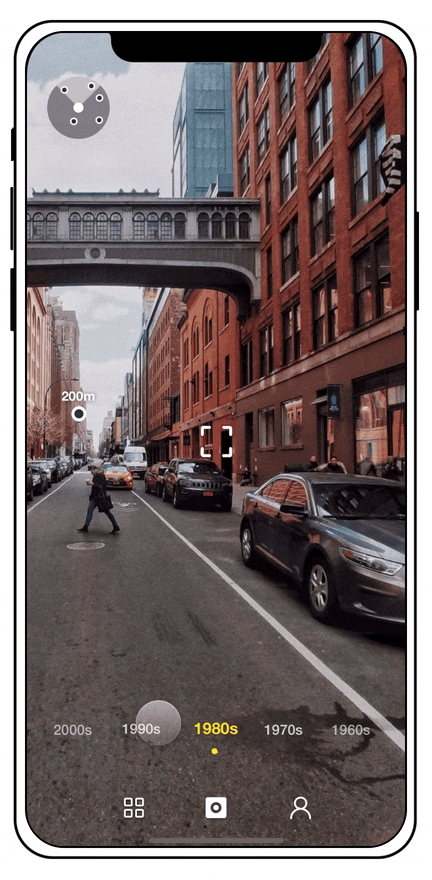

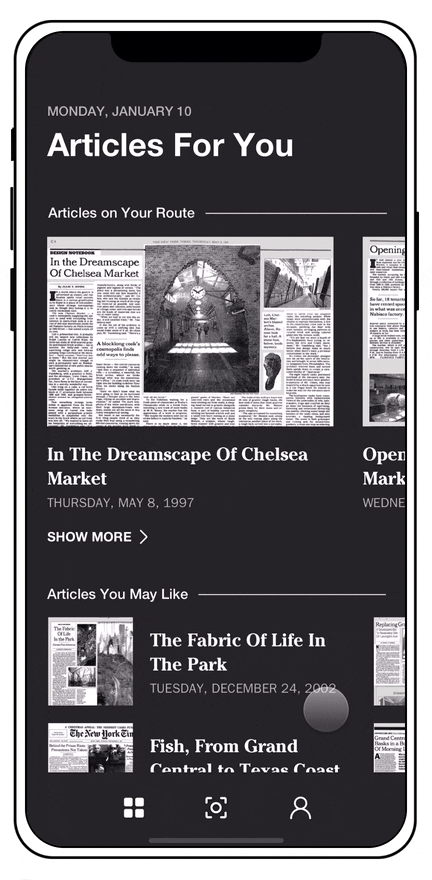
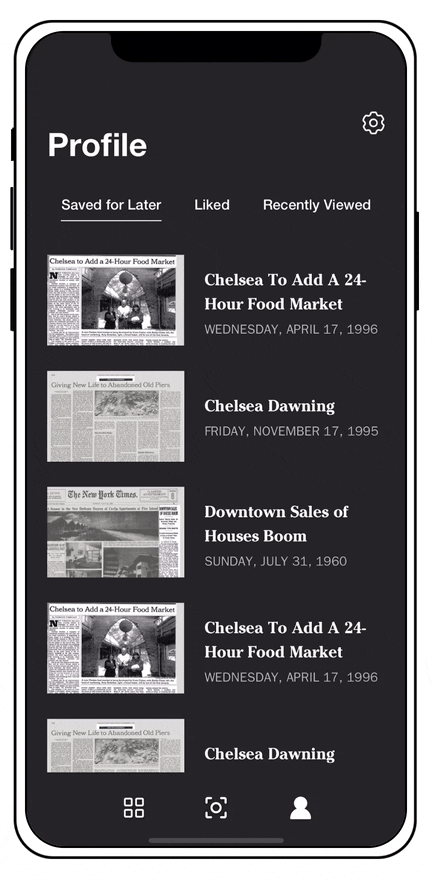

Identifying Goals —
Research01 *
First, we analyzed NYTs Mission & Approaches...
Our goal was to understand what it really means to become a contextual layer on top of the world.
▸ How is it changing the way users understand and interact with their context?
▸ Where, when and how are they intervening in a user's every day life?
▸ What are some benefits for the user to have NYTs as a "contextual layer" on top of the world?
We then dived deeper into NYTs current AR/VR Stories & Experiences...
Most of those experiences focus on turning news into 3D stories than can easily be experienced from the comfort of a user's home, as suggested in NYTs article: "Augmented Reality: How We'll Bring the News Into your Home".
Simultaneously, we conducted some qualitative user research...
...to better understand how users currently interact with, receive and search for news and how, when and where do they do so. From these conversations, we were able to identify 5 different types of users and key insights about their experiences.
(Synthesis - How, When & Where)
Key Insights
- Device: Users receive and interact with news mostly on their mobile phones.
- Notifications & Briefings: Some users rely on morning briefings on smart home devices, while others read headlines and notifications for general fast updates.
- Commute: Many users listen to the Daily Podcast on their commutes.
- Keywords: Users typically search the app for keywords on specific topics of interest
- AR/VR Content: Few have actually explored any AR/VR content on the NYTs app. Those who have were mostly excited about the technology and to see how it works.
- Context: Users remain disconnected from surroundings while experiencing news.
Approach —
Identifying Opportunities02 *
Synthesis & Opportunity
After synthesizing our initial research and during our brainstorming sessions, we noticed a gap in the way we receive news using XR technologies related to out-of-home experiences.
Guiding Questions
As a result, we rephrased our question to:
How can we expand the dimensions of news using XR technologies into spaces beyond our homes?
And as a brainstorming method, we then came up with a series of sub-questions that triggered different ideas and concepts:
Concept
We envision a future where New York Times not only becomes an omnipresent layer of journalistic material on top of the world,
but also, through news, contextualizes users in their environments and deepens citizen engagement and users’ connection to their cities.
Evaluating & Validating
To evaluate and validate our idea, we conducted a second round of research. The first step was to (1) validate the feasibility of this idea by searching the resources available by the New York Times while the second step was to (2) validate the value and need for such an experience for users by conducting another user research.
(1) NYT Research: Evaluating Feasibility & Resources
While searching the New York Times website, we came across NYT Time Machine and Archive pages - which are very navigable archives that consist of stories covered by NYTs since the 1850s till present. By simply searching some keyword(s), these archives show all results of articles that contain the inserted word(s). Stories can additionally be filtered by date or certain period of time.
(2) User Research: Evaluating Value & Validating Interest
For our second user test, we asked users about the type of news they typically search for or like to learn more about on their commutes in the city and if they currently have a method of receiving or searching for this information. We also asked them to share with us something they recently learnt or discovered on their commutes in the city and if and how they interacted with this information.
Journey Map
Quotes
Concept Modification
After our second round of research, we modified of our guiding questions to:
How might we provide new and engaging ways for users to receive and interact with the valuable historical, hidden and possibly forgotten urban stories?
And then modified our concept to become: A platform that leverages the NYT archives to build a large-scale geotagged AR experience in the city. This experience approaches space as a medium and interface for news that allows users to search and scroll through time for stories of interest in different locations across the city.
Such an experience allows NYT to “digitize & hybridize” traditional newspaper stories in a new form using AR technologies, to keep this content alive and turn it into a way to drive and deepen citizen engagement and user’s connection to their cities.
UX Flow —
Design03 *
To build this experience, and based on the insights from our research process, we defined features and key ideas to include in our app and specified user scenarios for each. We then developed the information architecture and designed our wireframes.
Flow Chart
Information Architecture
Mid-Fidelity Wireframes
Demo —
Prototype04 *
Scenarios —
MVP Features05 *


#1 AR Scan Articles in an Area
Users can scan surroundings for stories and scroll through time to discover more stories at different moments in history. When users are close to certain plaques, they can also scan those plaques for AR experiences of some stories.

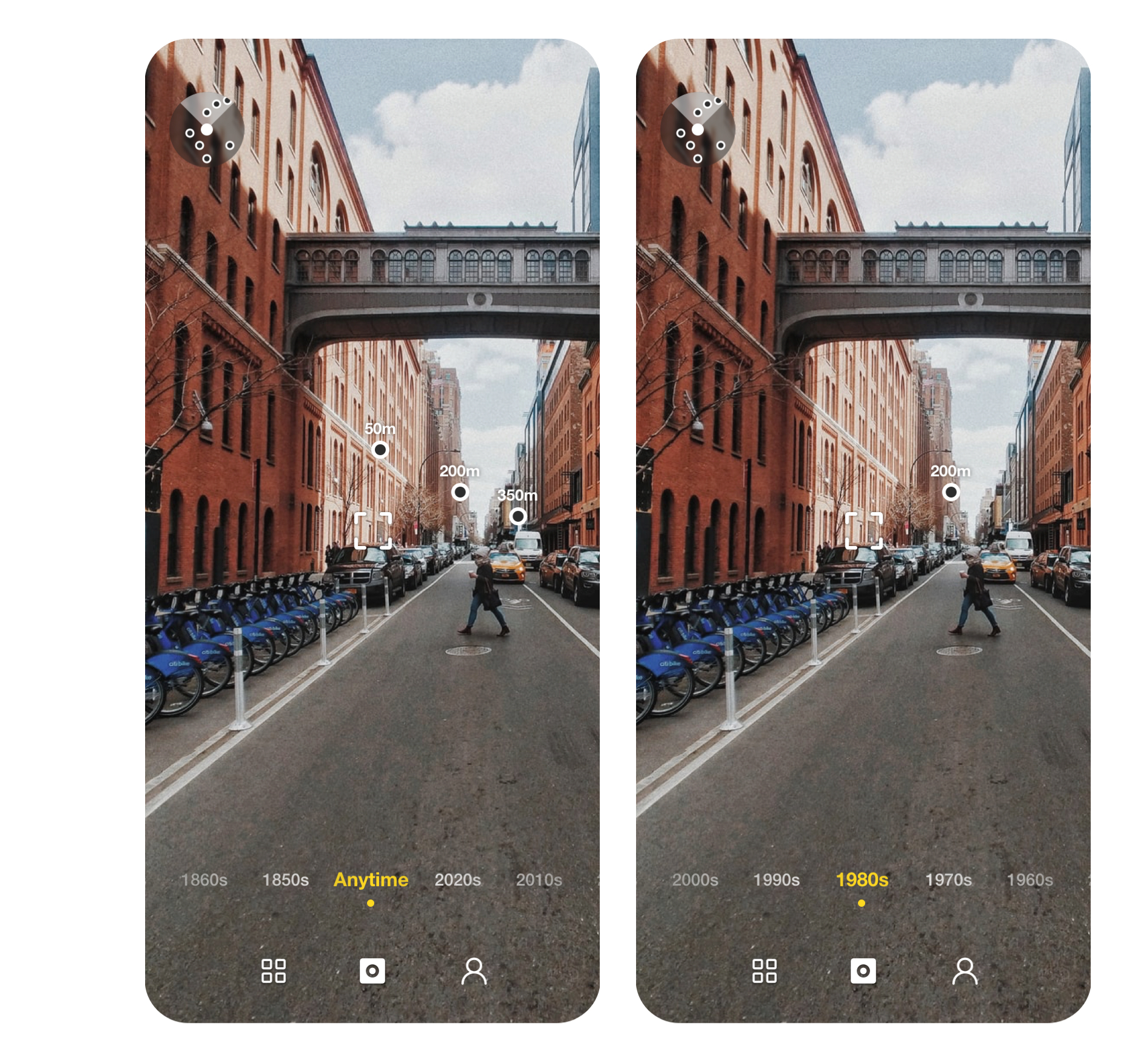
#2 Spatial Time Machine
Scrolling through time displays different stories in the city. Each year presented represents a decade of articles.
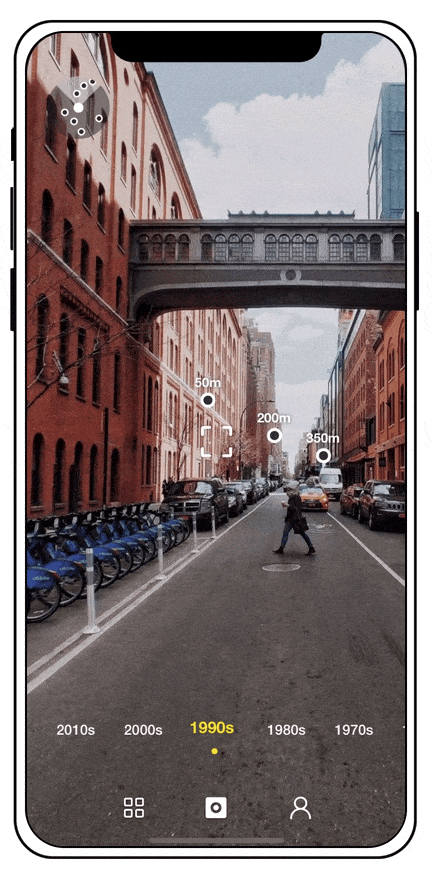

#3 All Articles Related to a Place
Once focused on a point in space, a list of articles shows up. Users can choose whichever they like to read or save for later.

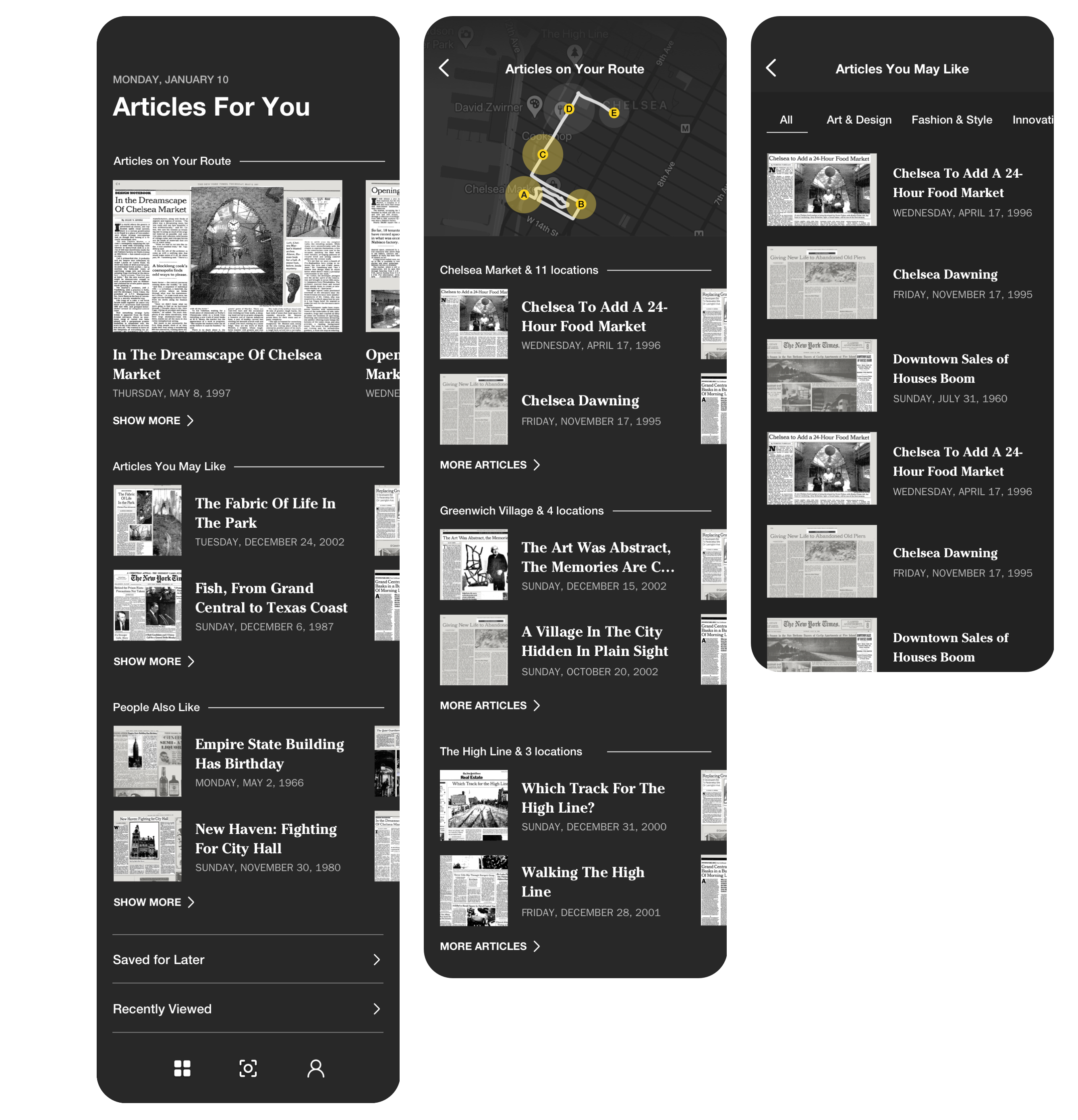
#4 Recommeded Articlles & Commute Experience
The app provides users with an option of tracking their commutes and visualizing interesting stories users have passed by. Articles are collected based on a user's preference, previously saved. A notification system can also alert users of hidden stories they might have encountered on their paths.

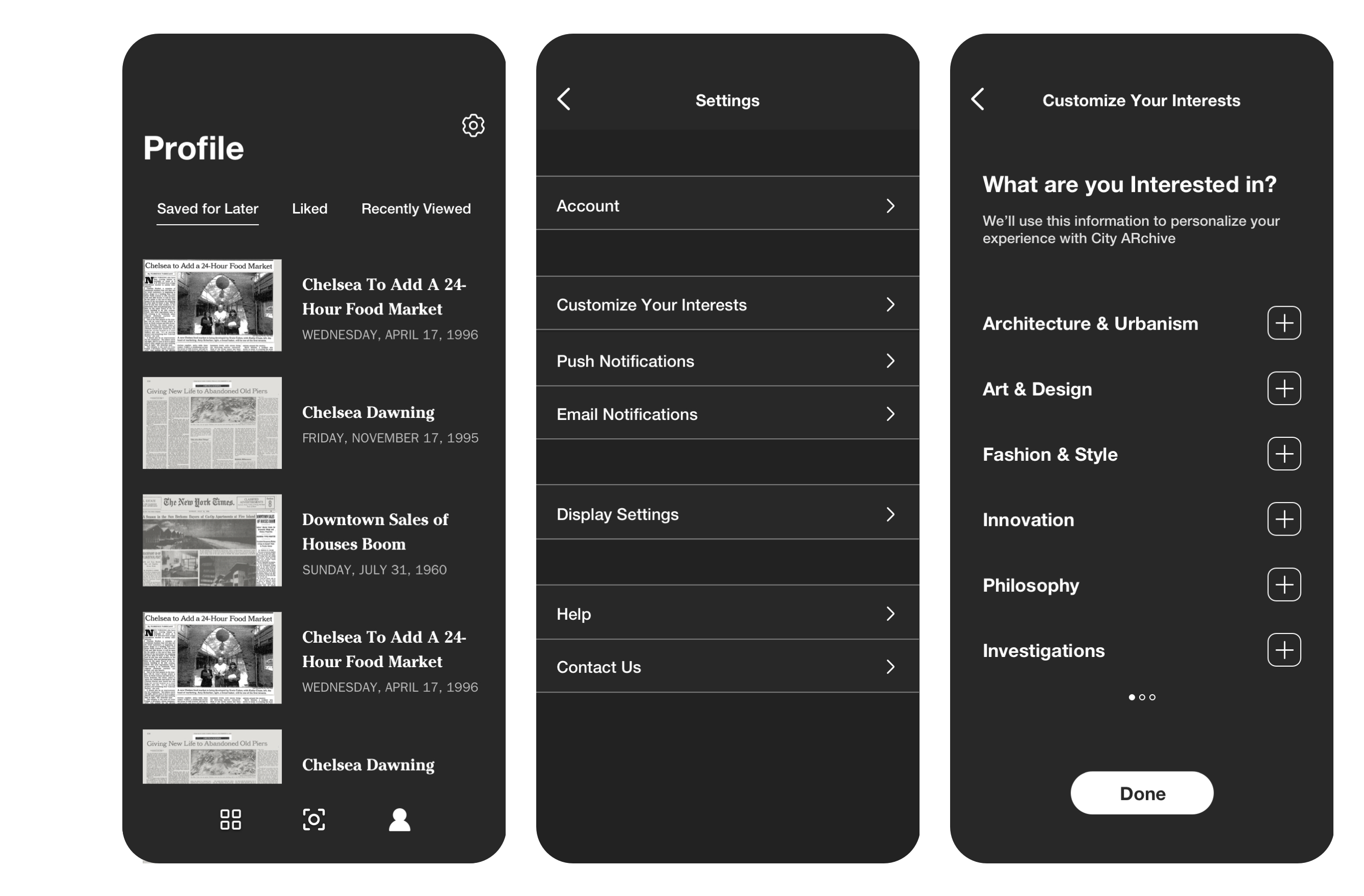
#5 Manage Interests
This information will be used to customize a user's experience with the app. By choosing interests, users get notifications whenever they are around stories they may like.

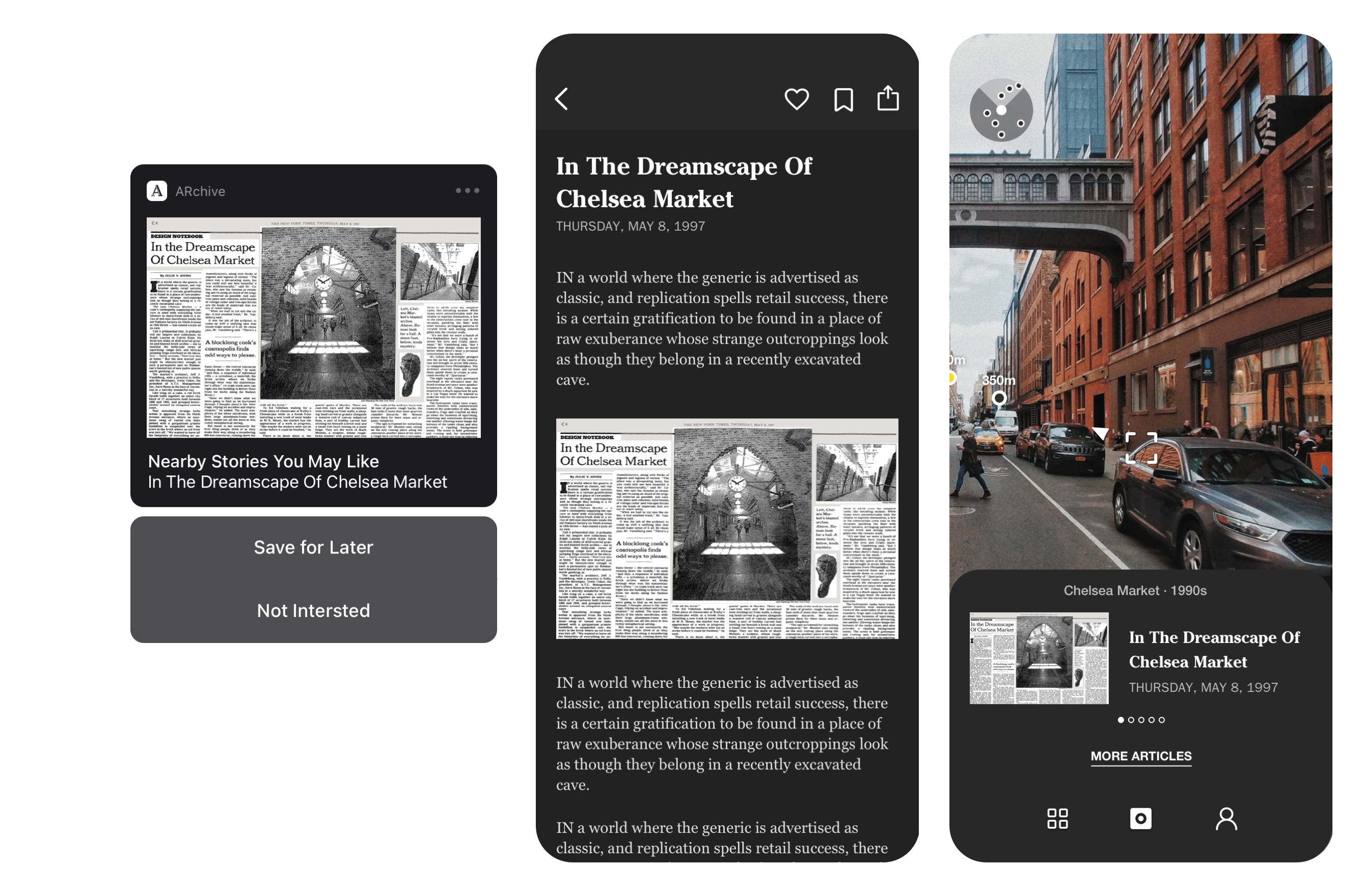
#6 Notification System
Users will get notified based on their previously set preferences as they walk past stories they might be interested in.
















